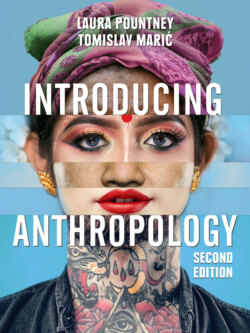Читать книгу Introducing Anthropology - Laura Pountney - Страница 134
Body techniques
ОглавлениеMarcel Mauss describes ‘techniques of the body’ as the ways in which the body is trained within any culture: ‘In every society, everyone knows and has to know and learn what he has to do in all conditions’ (2007[1934]: 66). Every biological and physiological skill of which the human body is capable, such as eating, washing, sitting, swimming, running, climbing, child-rearing and so on, has to be learnt. Mauss provides many examples of culturally varying body techniques, including the following observations:
Polynesians do not swim as the British do.
The French army does not march as the Germans do.
Girls who have been raised in convents, unlike other girls, tend to walk with their fists closed.
These techniques can change within one person’s lifetime. Mauss used the concept of ‘habitus’ (habit or custom, acquired ability) to describe these learnt techniques of the body. All humans have to eat in order to survive, but the way they eat, whether with a fork, with chopsticks or with their fingers, is a cultural construction. Mauss extends the study of society to include physiological experience and emphasizes both the point that the body is symbolically constructed and that the way in which it is used is as much a product of culture as it is of nature. The body must therefore be studied in the context of wider symbolic systems, and the way in which it is used and represented provides us with a mirror of society. Each society has its own special habits. Humans are conditioned in using the body in different ways through the process of socialization. The body is a person’s first and natural instrument, according to Mauss.
Gregory Bateson studied the people of the Balinese village Bajoeng Gede (Bateson and Mead 1962[1942]). He explains how children’s body positions are socially constructed. In order to separate themselves from animals that walk on all fours, the Balinese do not allow children to crawl. They separate themselves from animals and teach their children from the moment they are born how they should use their bodies. Babies grow up ‘vertically’ and are never allowed to crawl. From birth the body position is created by culture.
social construction The view that the phenomena of the social and cultural world and their meanings are created in human social interaction
Every culture teaches young ones how to use their bodies. Here, children are taking part in a school sports day in Sarawak, Malaysian Borneo. (© Liana Chua)
